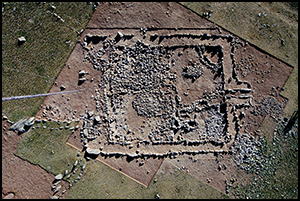Crossref Citations
This article has been cited by the following publications. This list is generated based on data provided by
Crossref.
Caspari, Gino
Betts, Alison
and
Jia, Peter
2017.
The Bronze Age in the Western Tianshan, China: A new model for determining seasonal use of sites.
Journal of Archaeological Science: Reports,
Vol. 14,
Issue. ,
p.
12.
Minardi, Michele
Betts, Alison V. G.
and
Khozhaniyazov, Gairatdin
2017.
Columned Halls in Ancient Chorasmia.
Iran,
Vol. 55,
Issue. 2,
p.
208.
Scarre, Chris
2017.
EDITORIAL.
Antiquity,
Vol. 91,
Issue. 360,
p.
1413.
2018.
ANNUAL BIBLIOGRAPHY.
Early China,
Vol. 41,
Issue. ,
p.
477.
Jia, Peter Weiming
Betts, Alison
Doumani Dupuy, Paula N.
Cong, Dexin
and
Jia, Xiaobing
2018.
Bronze Age Hill Forts: New evidence for defensive sites in the western Tian Shan, China.
Archaeological Research in Asia,
Vol. 15,
Issue. ,
p.
70.
Li, Yuqi
Storozum, Michael
Tian, Duo
Frachetti, Michael
Su, Kai
Wang, Xin
and
Islam, Rafiq
2019.
Farming strategies of 1st millennium CE agro-pastoralists on the southern foothills of the Tianshan Mountains: A geoarchaeological and macrobotanical investigation of the Mohuchahangoukou (MGK) site, Xinjiang, China.
PLOS ONE,
Vol. 14,
Issue. 6,
p.
e0217171.
Wright, Joshua
Ganbaatar, Galdan
Honeychurch, William
Byambatseren, Batdalai
and
Rosen, Arlene
2019.
The earliest Bronze Age culture of the south-eastern Gobi Desert, Mongolia.
Antiquity,
Vol. 93,
Issue. 368,
p.
393.
Leipe, C.
Long, T.
Sergusheva, E. A.
Wagner, M.
and
Tarasov, P. E.
2019.
Discontinuous spread of millet agriculture in eastern Asia and prehistoric population dynamics.
Science Advances,
Vol. 5,
Issue. 9,
Betts, A.
Jia, P.
and
Abuduresule, I.
2019.
A new hypothesis for early Bronze Age cultural diversity in Xinjiang, China.
Archaeological Research in Asia,
Vol. 17,
Issue. ,
p.
204.
Wang, Lu
Chen, Fan
Wang, Yongqiang
Qian, Wei
Mei, Jianjun
Martinón-Torres, Marcos
and
Chen, Kunlong
2019.
Copper metallurgy in prehistoric upper Ili Valley, Xinjiang, China.
Archaeological and Anthropological Sciences,
Vol. 11,
Issue. 6,
p.
2407.
Hermes, Taylor R.
Frachetti, Michael D.
Doumani Dupuy, Paula N.
Mar'yashev, Alexei
Nebel, Almut
and
Makarewicz, Cheryl A.
2019.
Early integration of pastoralism and millet cultivation in Bronze Age Eurasia.
Proceedings of the Royal Society B: Biological Sciences,
Vol. 286,
Issue. 1910,
p.
20191273.
Doumani Dupuy, Paula N.
Jia, Peter Weiming
Betts, Alison
and
Cong, Dexin
2019.
Pots and potters of the Bronze Age of north-west Xinjiang.
Antiquity,
Vol. 93,
Issue. 371,
p.
1231.
Jia, Peter
Caspari, Gino
Betts, Alison
Mohamadi, Bahaa
Balz, Timo
Cong, Dexin
Shen, Hui
Meng, Qi
and
Liu, Xinyi
2020.
Seasonal movements of Bronze Age transhumant pastoralists in western Xinjiang.
PLOS ONE,
Vol. 15,
Issue. 11,
p.
e0240739.
Sărășan, Adriana
Ardelean, Adrian-Cristian
Bălărie, Andrei
Wehrheim, Ruben
Tabaldiev, Kubatbek
and
Akmatov, Kunbolot
2020.
Mapping burial mounds based on UAV-derived data in the Suusamyr Plateau, Kyrgyzstan.
Journal of Archaeological Science,
Vol. 123,
Issue. ,
p.
105251.
Wang, Yingzhu
Rehren, Thilo
Tan, Yuchen
Cong, Dexin
Jia, Peter Weiming
Henderson, Julian
Ma, Hongjiao
Betts, Alison
and
Chen, Kunlong
2020.
New evidence for the transcontinental spread of early faience.
Journal of Archaeological Science,
Vol. 116,
Issue. ,
p.
105093.
Caspari, Gino
2020.
“Virtual dwellings” or architecture for the living? A hypothesis.
Archaeological Research in Asia,
Vol. 23,
Issue. ,
p.
100157.
Taylor, William Timothy Treal
Clark, Julia
Bayarsaikhan, Jamsranjav
Tuvshinjargal, Tumurbaatar
Jobe, Jessica Thompson
Fitzhugh, William
Kortum, Richard
Spengler, Robert N.
Shnaider, Svetlana
Seersholm, Frederik Valeur
Hart, Isaac
Case, Nicholas
Wilkin, Shevan
Hendy, Jessica
Thuering, Ulrike
Miller, Bryan
Miller, Alicia R. Ventresca
Picin, Andrea
Vanwezer, Nils
Irmer, Franziska
Brown, Samantha
Abdykanova, Aida
Shultz, Daniel R.
Pham, Victoria
Bunce, Michael
Douka, Katerina
Jones, Emily Lena
and
Boivin, Nicole
2020.
Early Pastoral Economies and Herding Transitions in Eastern Eurasia.
Scientific Reports,
Vol. 10,
Issue. 1,
Lu, Hongliang
Chen, Xinzhou
Zhang, Zhengwei
Tang, Li
Lemoine, Ximena
Wangdue, Shargan
Chen, Zujun
Liu, Xinyi
and
Frachetti, Michael D.
2021.
Early agropastoral settlement and cultural change in central Tibet in the first millennium BC: excavations at Bangga.
Antiquity,
Vol. 95,
Issue. 382,
p.
955.
Zhu, Jiangsong
Ma, Jian
Zhang, Fan
Cui, Yinqiu
Festa, Marcella
Xi, Tongyuan
Ren, Meng
Wang, Yinchen
Li, Ben
and
Huang, Feixiang
2021.
The Baigetuobie cemetery: New discovery and human genetic features of Andronovo community’s diffusion to the Eastern Tianshan Mountains (1800–1500 BC).
The Holocene,
Vol. 31,
Issue. 2,
p.
217.
Li, Yuqi
2021.
Agriculture and palaeoeconomy in prehistoric Xinjiang, China (3000–200 bc).
Vegetation History and Archaeobotany,
Vol. 30,
Issue. 2,
p.
287.





